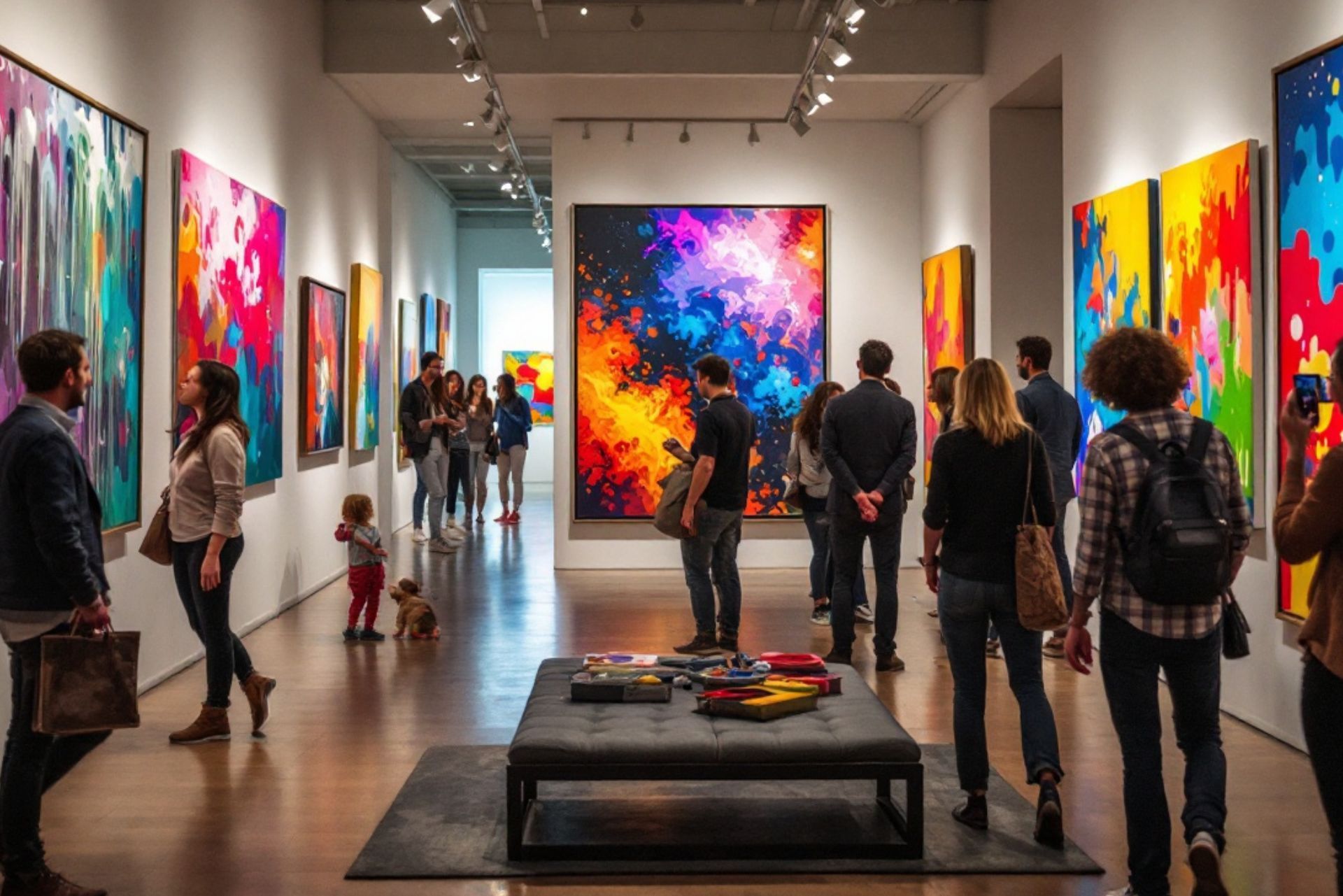
Most Common Business Policies
Index
Understanding the Basics of Art Gallery Insurance
Key Features of a Good Art Gallery Insurance Policy
The Process of Getting Art Gallery Insurance in New York
Cost of Art Gallery Insurance in New York
Managing and Updating Your Art Gallery Insurance
Legal Aspects of Art Gallery Insurance in New York
Conclusion: Protecting Your Art Gallery with the Right Insurance
Contact Us
Owning an art gallery in New York City offers many rewards but also presents several risks. One crucial aspect of running a successful art gallery is having the right insurance coverage. This article explores the different facets of art gallery insurance, including its importance, features, and the process of obtaining it.
Understanding the Basics of Art Gallery Insurance
Before diving into the specifics of insurance coverage, it's essential to understand what art gallery insurance entails. This type of insurance is designed to protect against a variety of risks associated with operating an art gallery.
What is Art Gallery Insurance?
Art gallery insurance is a specialized policy that caters to the unique needs of galleries that exhibit and sell artworks. This insurance typically covers the physical artworks, liability arising from the gallery's operations, and other associated risks.
In general, art gallery insurance can include coverage for theft, damage, and loss of artwork, as well as protection against liability claims from visitors or clients. It acts as a safety net, ensuring that gallery owners can focus on their business without constantly worrying about potential setbacks. Additionally, many policies can be tailored to include coverage for specific types of art, such as sculptures or installations, which may require different considerations due to their unique characteristics and value.
Why is Insurance Important for Art Galleries?
Insurance is a critical component of risk management for any business, and art galleries are no exception. Given the high value of artworks and the specific risks involved in handling them, insurance is not merely a luxury; it is a necessity.
Without insurance, art galleries could face substantial financial losses due to unforeseen events like theft, fire, or natural disasters. Furthermore, liability claims from injured visitors or disputes over sale transactions can lead to significant legal costs, further emphasizing the importance of reliable insurance. Moreover, galleries often host events, exhibitions, and private viewings, which can increase foot traffic and the potential for accidents. Having comprehensive insurance coverage ensures that gallery owners are protected against claims that could arise from these activities, allowing them to create a vibrant and engaging environment for art lovers without the constant worry of financial repercussions.
Additionally, art gallery insurance can provide peace of mind when it comes to transporting artworks. Whether shipping pieces to a new exhibition or moving them for restoration, the risk of damage during transit is a significant concern. Many insurance policies offer coverage specifically for transit, ensuring that artworks are protected from potential mishaps along the way. This aspect of insurance is particularly crucial for galleries that deal with high-value pieces, as even minor damages can lead to substantial financial losses and reputational harm.

Key Features of a Good Art Gallery Insurance Policy
When considering an art gallery insurance policy, it is essential to pay attention to its key features. A good policy should adequately cover various aspects related to the operation of an art gallery.
Coverage for Artworks
The primary feature of art gallery insurance is comprehensive coverage for artworks. This includes protection against various risks such as theft, vandalism, and accidental damage. Depending on the policy, some plans might also cover transportation risks when artworks are moved for exhibits.
When selecting coverage for artworks, it’s crucial to ensure that the policy reflects the true value of the collection. Consequently, regular appraisals may be necessary to maintain accurate coverage levels. Additionally, some policies may offer specialized coverage for high-value pieces, which can include provisions for restoration costs in the event of damage, ensuring that the artwork can be returned to its original condition.
Liability Protection
Art galleries are open to the public, which inherently increases the risk of liability claims. Good insurance policies should include robust liability protection that covers claims arising from accidents or injuries occurring on the gallery premises.
This can include incidents like a visitor tripping and falling or damage caused while art is being handled during an exhibition. Liability protection can safeguard gallery owners from potentially significant legal expenses. Furthermore, some policies may also extend coverage to include events hosted by the gallery, such as openings or workshops, where the risk of accidents may be heightened due to larger crowds and increased activity.
Business Interruption Coverage
Business interruption coverage can be vital for art galleries that may face temporary shutdowns due to unforeseen circumstances. This insurance feature compensates for lost income during periods when the business is non-operational, allowing owners to manage ongoing expenses without the stress of diminished cash flow.
In metropolitan areas like New York, where operational costs are high, having solid business interruption coverage can be a lifesaver. It provides a safety net that helps galleries navigate through challenging times. Additionally, some policies may offer extra features, such as coverage for expenses incurred while relocating to a temporary space, which can be particularly beneficial if the gallery needs to maintain its presence in the art community during repairs or renovations.
The Process of Getting Art Gallery Insurance in New York
Obtaining art gallery insurance requires a methodical approach to ensure that gallery owners find the right coverage tailored to their specific needs. The process can be broken down into several essential steps.
Evaluating Your Insurance Needs
The first step in obtaining insurance is to conduct a thorough evaluation of your gallery's insurance needs. This involves assessing the value of the artworks, understanding the potential risks involved, and determining the types of coverage necessary.
Gallery owners should make a comprehensive inventory of all assets, including artworks, equipment, and fixtures, to provide an accurate picture of what needs to be insured. Additionally, it is crucial to consider factors such as the gallery's location, foot traffic, and the types of exhibitions hosted, as these elements can significantly influence the level of risk. For instance, a gallery located in a high-crime area may require more robust coverage against theft, while one that frequently hosts large events may need additional liability protection.
Finding a Reliable Insurance Provider
Once you have outlined your insurance needs, the next step is to find a reliable insurance provider. Look for providers who specialize in art gallery insurance and have a solid reputation within the industry.
Consider consulting with other gallery owners for their recommendations and research various companies online to compare reviews and ratings. Don’t hesitate to take advantage of free consultations to discuss specific insurance needs and get a feel for customer service. It’s also beneficial to inquire about the insurer's experience with claims handling, as a provider that is well-versed in the nuances of art insurance can offer invaluable support during a claim process, ensuring minimal disruption to your gallery's operations.
Understanding the Policy Terms and Conditions
Before finalizing any insurance policy, it’s essential to carefully read and understand the terms and conditions. Pay particular attention to any exclusions or limitations that may apply to the coverage.
Never hesitate to ask for clarification on any part of the contract that seems confusing. A good insurer will be willing to explain how their policies work, ensuring that you have a complete understanding of your coverage. Additionally, consider discussing the possibility of adding endorsements or riders to your policy that could provide further protection, such as coverage for transportation of artworks to and from exhibitions or protection against
natural disasters. Understanding these nuances can make a significant difference in the overall security of your gallery's assets, allowing you to focus on showcasing art without the looming worry of unforeseen incidents.

Cost of Art Gallery Insurance in New York
Understanding the cost structure of art gallery insurance is vital for budgeting. Various factors can influence the overall cost of insurance premiums, and being aware of these can help gallery owners navigate the complexities of their insurance needs.
Factors Influencing the Insurance Cost
Several factors can impact the cost of insuring an art gallery, including:
- The total value of the artworks being insured.
- The gallery’s location and the associated risks (e.g., crime rates in the area).
- The types of exhibitions hosted and the frequency of events.
- The overall claims history of the gallery or the owner.
Understanding these factors can help gallery owners assess their risk profile and make informed decisions about their insurance coverage. For instance, galleries located in high-crime neighborhoods may face higher premiums due to the increased risk of theft or vandalism. Additionally, galleries that frequently host high-profile exhibitions may require specialized coverage to protect against unique risks associated with showcasing valuable or rare pieces. Furthermore, the reputation of the gallery and its history of claims can also play a significant role in determining premiums; a gallery with a clean claims history may be viewed as less risky by insurers, potentially leading to lower costs.
Ways to Reduce Your Insurance Premiums
Reducing insurance premiums is a priority for many gallery owners. There are various strategies to achieve this, including:
- Increasing deductibles: Higher deductibles typically lead to lower premiums.
- Implementing risk management strategies: Improving security measures, like installing alarm systems or surveillance cameras, can decrease premium costs.
- Bundling policies: Purchasing multiple types of insurance from the same provider can result in discounts.
By actively managing risks and being strategic about choices, gallery owners can effectively lower their insurance costs. Additionally, engaging in regular assessments of security protocols and staying updated on best practices in risk management can further enhance a gallery's safety profile. For example, conducting routine audits of security systems and ensuring staff are trained in emergency procedures can not only mitigate risks but also demonstrate to insurers that the gallery is proactive about safeguarding its assets. Moreover, participating in local art community initiatives or insurance programs designed for the arts can provide additional resources and potential savings on premiums, fostering a supportive network among gallery owners.
Managing and Updating Your Art Gallery Insurance
Insurance management doesn’t end once a policy is purchased. Ongoing evaluation and updates are necessary to ensure that coverage remains adequate as the gallery evolves.
Regular Appraisals and Insurance Updates
Regular appraisals are essential for maintaining the correct value of artworks. As the art market fluctuates, the value of pieces can increase or decrease significantly, necessitating adjustments to insurance coverage.
Gallery owners should schedule annual reviews of their insurance policy and inventory to update values and ensure comprehensive coverage aligns with current market conditions. Additionally, it’s wise to stay informed about trends in the art world, as certain styles or artists may gain popularity, leading to increased value. Engaging with professional appraisers who specialize in the gallery's focus can provide insights that go beyond mere monetary valuation, encompassing factors like provenance and market demand, which can further influence insurance needs.
Claim Process and Settlement
Understanding the claims process is also crucial for art gallery owners. In the event of a covered loss, it’s important to know how to file a claim correctly and what documentation will be required.
Documentation typically includes proof of ownership, value appraisals, and photographs of the damaged or lost item. Being prepared with the right information can streamline the claims process, resulting in a quicker settlement. Furthermore, it’s beneficial to maintain a detailed inventory log that includes not only the artworks but also their condition reports, which can serve as vital evidence in the event of a claim. Establishing a relationship with an insurance adjuster who understands the nuances of art can also facilitate smoother negotiations and ensure that the gallery receives fair compensation for its losses.
Legal Aspects of Art Gallery Insurance in New York
Art gallery owners in New York must also be aware of the legal aspects surrounding insurance. The laws governing insurance can often be complex and vary from state to state.
New York State Insurance Laws and Regulations
New York State has specific regulations pertaining to insurance policies, including requirements for minimum coverage levels and regulations concerning surplus lines. Understanding these regulations can help gallery owners navigate their insurance options more effectively.
Gallery owners should stay informed about changes in state laws that may impact their insurance requirements to ensure compliance and proper protection. Additionally, New York has unique provisions regarding the valuation of art, which can influence how policies are structured. For instance, the state recognizes the importance of appraisals and may require galleries to provide documented valuations for their collections to ensure adequate coverage. This can help mitigate disputes during claims processes, as having a clear, agreed-upon value for artworks can streamline negotiations with insurers.
Legal Disputes and Art Gallery Insurance
Like any business, art galleries may face legal disputes that could involve their insurance policies. Issues can arise related to coverage denials or interpretations of policy terms.
In such cases, having legal help may be essential. Working with attorneys who specialize in insurance law can provide gallery owners with the guidance needed to navigate disputes efficiently and protect their business interests. Furthermore, understanding the nuances of liability coverage is crucial, especially in a city like New York, where galleries often host events and exhibitions. Liability claims can stem from accidents or damages occurring during these events, and having the right insurance can protect gallery owners from potential financial ruin. Legal counsel can assist in reviewing policy language to ensure that all potential risks are adequately covered, thus providing peace of mind in an industry that thrives on creativity and expression.
Conclusion: Protecting Your Art Gallery with the Right Insurance
In summary, having the right art gallery insurance is crucial for protecting your investment and ensuring the smooth operation of your business. From understanding the importance of coverage to navigating the complexities of selection, costs, and legalities, it is vital to approach insurance with diligence.
By taking the time to evaluate your needs, choosing a reliable provider, and managing your policy properly, you can focus on what truly matters—showcasing the incredible artworks that define your gallery. Ensuring proper coverage will provide peace of mind, allowing you to thrive in the dynamic art world in New York.
